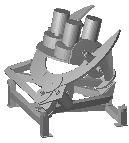 M 31 (Andromeda), 10 minute, no filter
M 31 (Andromeda), 10 minute, no filter
 Orion Nebula, 10 s, no filter
Orion Nebula, 10 s, no filter
 North Polar Sequence, 30 s, no filter
North Polar Sequence, 30 s, no filter
 North Polar Sequence, 30 s, I filter
North Polar Sequence, 30 s, I filter

The first step bringing us closer to the desired goal is the prototype ASAS instrument, equipped with 768x512 Kodak CCD and 135/1.8 telephoto lens, mounted on the computer controlled robotic mount, which was developed at the Warsaw University Astronomical Observatory and since April 7, 1997 operates at the Las Campanas Observatory, Chile. Prototype takes about 15 3-minute exposures (covering 90 sq. deg.) per hour with limiting I-magnitude 13 and resolution of 14 arcsec/pixel. Initial setup consisted of 24 fields covering 150 sq. deg. (later increased to 50 fields - 300 sq. deg) monitored few times each night.
January 10, 1997 - The Prototype is out of operation due to the flying washers inside the MEADE camera head. Camera was send to US for fixing/replacement. How long it'll take - God knows. Short MEADE Service Policy story describes the situation.
 M 31 (Andromeda), 10 minute, no filter
M 31 (Andromeda), 10 minute, no filter
 Orion Nebula, 10 s, no filter
Orion Nebula, 10 s, no filter
 North Polar Sequence, 30 s, no filter
North Polar Sequence, 30 s, no filter
 North Polar Sequence, 30 s, I filter
North Polar Sequence, 30 s, I filter